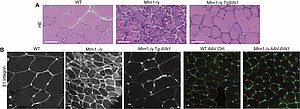Publication date: 23/04/19
ThemesNews
Researchers at the Institute of Genetics and Molecular and Cell Biology have discovered how myotubularin, a protein deficient in myotubular myopathy, interacts with amphiphysin 2. They propose focusing on this for the treatment of patients. This work was published on 20 March 2019 in Science Translational Medicine.
Myotubular myopathy is a rare genetic disorder, affecting about one in 50,000 children. It is linked to a mutation on the MTM1 gene located on the X chromosome, and is manifested by a decrease in adhesion of the muscle cells to each other, and an alteration of the muscle fibres. This phenomenon causes severe muscle weakness, including respiratory failure, and causes premature death with two-thirds of patients not living beyond two years of age. To date, there is no treatment.
By exploring the interactions of myotubularin, a protein encoded by the MTM1 gene, with another protein, the amphiphysin 2 encoded by the BIN1 gene, also expressed in muscles and involved in similar myopathies, the team from Pathophysiology of neuromuscular diseases (IGBMC), led by Jocelyn Laporte, has discovered how these proteins work together, and offers a new therapeutic target.
















